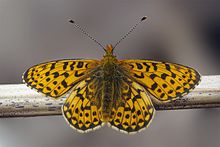Pearl bordered fritillary
| Pearl-bordered fritillary | |
|---|---|
 |
|
| Scientific classification | |
| Kingdom: | Animalia |
| Phylum: | Arthropoda |
| Class: | Insecta |
| Order: | Lepidoptera |
| Family: | Nymphalidae |
| Genus: | Boloria |
| Species: | B. euphrosyne |
| Binomial name | |
|
Boloria euphrosyne (Linnaeus, 1758) |
|
The pearl-bordered fritillary (Boloria euphrosyne) is a butterfly of the Nymphalidae family found in Europe and northern Asia.
It is orange with black spots on the upperside of its wing and has a wingspan of 38–46 mm. On the underside of the wings there is a row of silver-pearly markings along the edge, which give the species its name. It is often confused with the small pearl-bordered fritillary, but can be distinguished from it by the triangle along its pearl border (the small pearl-bordered has black chevrons) as well as the presence of a single silver spot in the middle of a row of yellow spots. The female has both darker markings and rounder wings than the male. The caterpillars are black with white or yellow spines along their backs.
Like other species of fritillary, the males have special scent glands on their wings so that they can be recognised by females of their own species and therefore find a suitable partner.
Dorsal side
Ventral side
The pearl-bordered fritillary is widespread throughout Europe, ranging from Scandinavia to northern Spain and from Ireland eastwards towards Russia and Asia. In England and Wales (plus another 10 countries) it has declined rapidly in number and is a highly threatened species - nbn gateway distribution map.
After mating, the female will lay her eggs on dead bracken (Pteridium aquilinum), or leaf litter near to violet plants – common dog–violet (Viola riviniana), heath dog–violet (Viola canina) or marsh violet (Viola palustris). Sometimes they are laid on the leaves of the food plant itself. They are laid singly, not in one large group such as the marsh fritillary. The mosaics that they prefer are typically one–third grass and two–thirds bracken.
Eggs can be found on the food plant from mid–May to the end of June. They are a pale yellow and can hatch after 10–14 days.
...
Wikipedia
